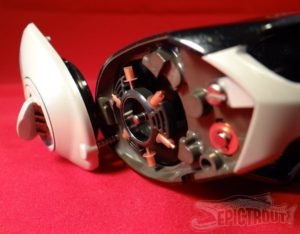Chronarch 20 E6 &Clarus CSC-86m2b IM-8

Finding the right combination
By Brad Stout
Once upon a time I wrote an article titled “Trophy Trout Fishing With Your Kids.” In the article I went over my reasons for the rods used to catch trophy size trout with kids. When I wrote the article I talked about how my young girls needed a fiberglass rod to act more like a shock absorber and the sensitivity of the rod didn’t matter much . The craziest thing is that my kids are growing up and fast! Katie, now a teenager, has out grown her fishing rods and is now using my equipment. My yellow fiberglass Eagle Claw rods still work great for down riggers but for casting, top line trolling, and especially vertical jigging, they simply weren’t going to work.
I let the fish dictate to me how I should fish for them. I have always adapted to whatever it takes for me to catch them at any given time. Trolling down riggers is a fantastic tool but it’s definitely not the only way to catch fish. As most of you well know top lining in the spring and fall is very effective. Casting around structures can be equally deadly at certain times of the year and for me vertical jigging has been an extremely effective tool. So when I started looking for a rod and reel combo for Katie, I wanted one that would cover all of her needs. In time, Katie will need three rod and reel combos . One designed especially for its own task, but for now I set out to find one combo to do all three.


The reel I would choose for Katie is one that I would have gladly used for myself. The Chronarch 201 Series E6 fits her needs perfectly. With the weight of 7.6 ounces it would feel like a feather in her hands. The shape of the low profile reel is so compact and easy to grip it makes for hours of comfortable fishing. I would outfit the reel with 6 to 8 pound test copolymer fishing line. When trolling I like to run my lure around 150 to 350 feet back so the Chronarch line capacity would work perfectly holding 540 feet of 8 pound test. The next thing I look for is gear ratio. Gear ratio is one of the most overlooked specification anglers look at in a reel. The Chronarch comes in three models for the 201 Series: E5 with a gear ratio a 5.5; E6 with a gear ratio of 6.5; and E7 with a gear ratio of 7.0. So what does all this gear ratio nonsense mean in the real world? The lower the gear ratio number the more torck it has for winching in trophy trout. But I’m more interested in the line retrieve per crank in inch. The higher the gear ratio number the more line you will retrieve with every turn of the reel handle. With a gear ratio of 5.5, your reel gains 24 inches per rotation of the handle. With a gear ratio of 6.5, you gain 27 inches per rotation. With a gear ratio of 7.0, you gain 30 inches per rotation. Here lies the dilemma. You want a lower gear ratio to winch in your fish and a higher gear ratio to retrieve your lure faster once a run is over. For the style of fishing that we will be doing, the E6 with a gear ratio of 6.5 is the overall winner for us.


Next, I must decide which rod will marry perfectly to the reel of my choice. For casting, trolling, and jigging, we need a fast action graphite rod with the perfect balance of length, power, and action. We decided on the Shimano Clarus CSC-86m2b IM-8 Graphite steelhead rod. This rod is 8’6″ in length which is ideal for trolling because it keeps your line as far away from the boat as possible and the extra rod length will help you set the hook. The forgrip is 2″ and the rear grip of the rod is 12.375 inches long which allows the butt of the rod to nestle nicely in the crook of the elbow and chest while ripping the shoreline fishing for browns or under the forearm and elbow while vertical jigging and fighting a fish. The power of the rod is listed as medium so it’s still spongy enough to land a monster trout on 8 pound test. Lastly, the Clarus has an over-the-counter Limited Lifetime Warranty.
Over the years, I have made several great contacts by pro staffing with several companies, one being Shimano. I enjoyed being on the Shimano Pro Staff, but due to my busy lifestyle and raising two kids, I had to step away from pro staffing. After recently making a quick phone call to my old friends at Shimano, I was happy to learn that they agreed to accommodate my needs and sent me some demo pro staff goodies even though I no longer work for them. I just want to thank you guys at Shimano!
My rod and reel combo looks good on paper but how does it work in the real world? Katie and I decided to set out for the 2013 fishing season to put her rod and reel through the ringer.
The first test is casting. Katie knows how to cast a spinning reel and does it with ease but switching her over to a bait caster took her a little time to get adjusted. Within 10 minutes and a dozen gnarly backslashes Katie started to get frustrated. Her overruns were coming at the beginning of the cast. The Chronarch has 6 brakes hidden behind a cool flip up door. By turning on 3 of them on the over run the problem was fixed. Over the next half hour her cast became smoother and went farther. Like most trout guys, I know Katie definitely prefers a spinning reel over a bait caster when it comes to casting. After we casted for a while Katie informed me that she was not overly impressed with her new set up.
The second test is trolling. I tied on one of my all-time favorite lures, the Rapala 13 Husky. Katie anxiously took the rod from me and immediately dropped the lure into the water as we started trolling and then bam, instant backlash. Katie turned to me with “this new reel sucks” look on her face. I laughed as I showed her how the cast control knob works. I turned the cast control knob to a higher setting as we dropped the lure into the water. I then slowly turned the cast control down as the line effortlessly melted off the spool. I explained that every lure has a different resistance and the cast control knob would have to be adjusted accordingly. We then measured how much line was going out as the line went from one end of the spool and back to the starting point. We found with one complete travel across the spool and back equalled roughly 15 feet. Wanting to fish 165′ behind the boat, I instructed Katie to make 11 full passes on the spool. Suddenly as Katie worked the rod in her hands she shouted “I got one and it’s a fighter!” She is accustomed to the slow reaction of a fiberglass rod and how the reel would seldom give drag. The fiberglass rods work great for getting fish to the boat but it takes most of the enjoyment of fighting the fish out with its bungee, shock-like action. With the new graphite rod Katie could now feel every head shake, every run, and every time the fish wants to show its power. Katie loved every second of the fight as the line screamed off the reel. When we netted the 6 pound Mackinaw she replied “That’s it? That fish fought harder than most of my bigger fish.” After explaining the benefits of the graphite rod I asked” So Katie, how do you like your rod and reel combo now? ” She didn’t say a word, only flashed me her big, beautiful smile.
The third and hardest test is jigging. Katie has now figured out the basic functions of the rod and reel. How the thumb bar lets line out instantly. By adjusting the cast control knob Katie could get her line out as fast as possible in a controlled environment. How one full pass on the spool equals 15′ of line and last but not least how one full rotation of the crank equals 27″. This may sounds like a bunch of hum-bo-jumbo to some people but not me. You see, the key to jigging is to put and keep your jig in the strike zone as long a possible. Once you graph a fish you need to get your jig down to it as soon a you can and that’s where the cast control knob comes into play. Any hesitation, tick, or acceleration in line speed on the drop could be a fish and you don’t want a backlash to occur at this moment . For example, lets say that we see a fish suspended at 45′. I simply instruct Katie to let out 3 full passes of line on the spool and she is there. Then let say that fish disappears on the sonar and we see another one suspended at 36′, I would instruct Katie to give the crank 4 full turns on the reel. 4 cranks at 27″ equals 108″ divided by 12″ per foot equals 9 ‘ and just like that she’s back in the strike zone. The strike of a fish while jigging is something very few can feel even when you are doing everything right and all of the proper steps and procedures are in place. Some just can detect the strike but cant set the hook fast enough. That is where the Clarus 8’6″ graphite rod comes in. This rod is so sensitive that you can detect the slightest strikes from the fish. The extra length allows your jig to travel further through the water with more energy allowing for better hook sets.


Like any proud father, I’m going to brag a little about my daughter Katie. She is a natural when it comes to jigging. This may sound funny but I can tell when someone has figured out the techniques necessary to be successful at jigging. It’s not necessarily the amount of fish that one catches but the ability to know that they’re missing fish. There are a couple of ways fisherman can catch fish while jigging. The first way is by doing a robotic jigging motion with their rod and then the rod loads up and the fish is hooked. Its important to know that in this situation even though the fisherman was jigging in the strike zone, he was extremely lucky to hook that fish. Chances are the fish had already hit the jig towards the end of the drop and by transitioning to the upward swing the fisherman unknowingly set the hook on the fish. Another other way is when you actually detect a strike and instinctively set the hook as hard as you can without giving it a second thought. This is the gift that Katie possesses. Knowing you just missed a fish helps build confidence that you are doing the right technique and that you are in complete harmony with your jig. Katie tells me things like “I just missed it” ,” I had a tap” or “dang fish just fouled my jig” all right after an explosive missed hook set. For those of you who are new to jigging, if you notice a change after jigging for a few minutes using the same rhythm and then reel in your jig only to find that it has been fouled, this means that a fish hit your lure but you never felt it. Katie loves her new rod and reel and we found out that her favorite way to fish is now vertical jigging. Katie and I have spent most of our time fishing together during the summer with her learning how to master this technique.
Katie’s new reel and rod combo gave her the ability to grow as an angler. The reel gave her the ability to know exactly where her lure was located whether she was casting, trolling, or vertical jigging and the rod gave her the sensitivity to know exactly what the lure was doing at all times. However, the greatest gift that the reel and rod gave her was the ability to step outside of her everyday life and comfort zone, If only for a few moments when she’s concentrating on her lure and the rod becomes a mere extension of her arm, Katie gets lost in that special place that can only be described as fishing.




